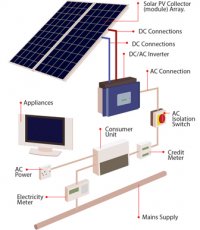How Does it Work
How Do Photovoltaic's (PV) Cells Work?

PV cells are panels you can attach to your roof or walls. Each cell is made from one or two layers of semiconducting material, usually silicon. When light shines on the cell it creates an electric field across the layers. The stronger the sunshine, the more electricity is produced.
PV cells come in a variety of shapes and colours, from grey "solar tiles" that look like roof tiles to panels and transparent cells that you can use on conservatories and glass.
The strength of a PV cell is measured in kilowatt peak (kWp). That's the amount of energy the cell generates in full sunlight
The electricity generated by a solar pv system is either stored in batteries in the case of off-grid systems, or used within the home and any excess can be exported back to the main electricity networks.
To use the electricity generated in the home a device called an inverter is used, this equipment converts the DC electricity generated from the PV panels to standard 230V AC, and from there can be used or exported to the national grid.
Due to the growing demand for renewable energy sources, the manufacture of solar cells and photovoltaic arrays has advanced considerably in recent years.
Between 2004 and 2010, grid-connected PV capacity increased at an annual average rate of 60 %, to 21 GW, with Britain being cited as the fastest growing solar economy in Europe, with current estimates reflecting a 1500 % growth since 2009.
Photovoltaic arrays are often associated with buildings: either integrated into them, mounted on them or mounted nearby on the ground. Arrays are most often retrofitted into existing buildings, usually mounted on top of the existing roof structure or on the existing walls.
Alternatively, an array can be located separately from the building but connected by cable to supply power for the building.
The power output of photovoltaic systems for installation in buildings is usually described in kilowatt-peak units (kWp).
Financial Benefits
The installation of a solar PV system benefits you in not only generating clean renewable energy and helping to reduce your carbon footprint. It is also a very good financial investment generating a yearly income and adding value to your home.
Once the initial outlay of the system is paid for, your PV system will then begin to payback the cost of install, typically this can take between 8 - 12 years.
- By generating your own electricity you will import less from the National Grid and therefore reduce your overall energy bills.






